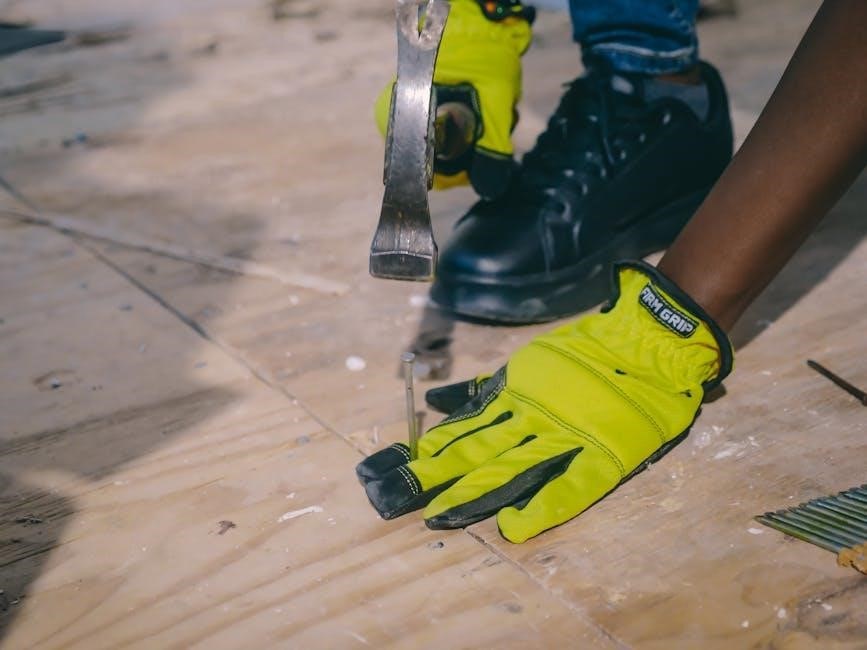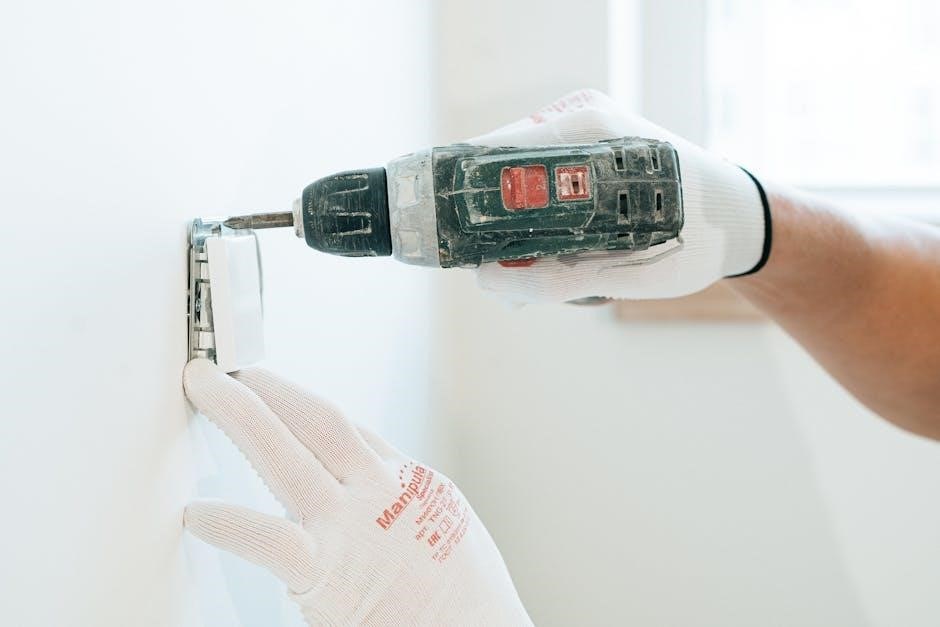Honeywell RTH2300 Installation Manual: A Comprehensive Guide
This comprehensive guide provides detailed instructions for installing the Honeywell RTH2300 thermostat. It covers everything from identifying your system type and gathering necessary tools‚ to understanding wiring connections and mounting the thermostat. Whether you are a seasoned DIY enthusiast or a first-time installer‚ this guide helps ensure a smooth and successful installation process.
The Honeywell RTH2300 thermostat is a user-friendly‚ programmable thermostat designed for easy climate control in your home. This model offers a balance of simplicity and functionality‚ providing reliable performance and energy savings. It features a clear‚ backlit display for easy viewing‚ even in low-light conditions. The RTH2300 allows for both temporary and permanent overrides of the programmed schedule‚ giving you flexibility in managing your home’s temperature. It is compatible with various systems‚ including gas‚ oil‚ and electric furnaces‚ as well as central air conditioning and hot water systems. However‚ it is not suitable for multi-stage conventional systems or heat pumps with backup heat.
Installing the Honeywell RTH2300 is a straightforward process‚ often taking less than 30 minutes. This guide provides a step-by-step approach to ensure a successful installation. The RTH2300 is designed to provide years of reliable service. With one-touch access to setpoint temperature and preset program settings‚ it offers convenient climate control. Before beginning the installation‚ it’s important to identify your system type and ensure compatibility with the thermostat. If you are unsure about your system‚ consulting a professional is recommended. The RTH2300 offers a cost-effective way to maintain a comfortable home environment while optimizing energy consumption.
Identifying Compatible System Types
Before installing the Honeywell RTH2300 thermostat‚ it’s crucial to determine if it’s compatible with your existing heating and cooling system; The RTH2300 is designed to work with a range of systems‚ including gas‚ oil‚ and electric furnaces‚ central air conditioners‚ and hot water systems (with or without a pump). It’s also compatible with millivolt systems and central heating and cooling setups. However‚ this thermostat is not compatible with multi-stage conventional systems or heat pumps that utilize auxiliary or backup heat.
To identify your system type‚ examine your existing thermostat and HVAC equipment. Look for labels or markings indicating the system type. If you’re unsure‚ consulting your system’s documentation or contacting a qualified HVAC technician is recommended. Correctly identifying your system prevents damage to the thermostat or your HVAC equipment and ensures optimal performance. The RTH2300 thermostat will work on 24 volt or 750 mV systems. Prior to installation carefully review the specifications of your existing system to confirm compatibility with the RTH2300 thermostat.
Tools and Materials Needed for Installation
Before beginning the installation process of your Honeywell RTH2300 thermostat‚ gathering all the necessary tools and materials ensures a smooth and efficient experience. Essential tools include a Phillips-head screwdriver for removing the old thermostat and securing the new wall plate. A small flat-head screwdriver may also be helpful for wiring connections. You’ll need a pair of wire strippers to prepare the wires for connection to the new thermostat. A level is crucial for ensuring the thermostat is mounted straight on the wall for aesthetic purposes.
In terms of materials‚ make sure you have the new Honeywell RTH2300 thermostat‚ which includes the thermostat unit and the wall plate. You’ll also need two new AAA batteries to power the thermostat. Wire labels are essential for properly identifying and connecting wires from your old thermostat to the new one. Finally‚ consider having a drill with appropriate drill bits for creating new mounting holes if necessary and wall anchors if the existing holes are too large. Safety glasses are also recommended to protect your eyes during the installation. Having these tools and materials readily available minimizes interruptions and facilitates a successful installation.
Step-by-Step Installation Process
The installation of the Honeywell RTH2300 thermostat involves several key steps to ensure correct operation. Begin by turning off the power to your heating and cooling system at the breaker box. Next‚ carefully remove your old thermostat from the wall‚ taking note of the wire connections. Label each wire with the provided wire labels‚ matching them to the corresponding terminals on your old thermostat. This step is crucial for easy reconnection later. Detach the old wall plate from the wall.
Now‚ mount the new Honeywell RTH2300 wall plate to the wall using the provided screws‚ ensuring it is level for aesthetic purposes. Connect the labeled wires to the corresponding terminals on the new wall plate‚ referring to the wiring diagram in the manual for accuracy. Gently push any excess wire back into the wall. Insert the two AAA batteries into the back of the thermostat. Finally‚ align the thermostat with the wall plate and snap it into place. Turn the power back on at the breaker box and follow the setup instructions to configure your thermostat settings.
Wiring Connections: A Detailed Guide
Proper wiring is paramount for the Honeywell RTH2300 thermostat to function correctly. Before commencing‚ always disconnect power to prevent electrical shock. Carefully examine the existing wiring configuration of your old thermostat‚ noting the colors and terminal designations. The RTH2300 is compatible with various systems‚ but it’s crucial to identify the correct wires. Common terminals include R (power)‚ W (heat)‚ Y (cooling)‚ G (fan)‚ and C (common wire ⎻ if present).

For standard systems‚ match the labeled wires from your old thermostat to the corresponding terminals on the RTH2300 wall plate. If you have a heat pump system‚ consult the wiring diagrams in the manual to determine the correct connections‚ as these systems often use different wire designations. Ensure each wire is securely connected to its respective terminal. Avoid loose connections‚ as they can lead to operational issues. If your old thermostat had a jumper wire between R and Rc terminals‚ it may need to be removed for proper operation. If unsure‚ seek professional assistance to prevent damage to your system or thermostat.
Mounting the New Wallplate
After safely disconnecting the power and removing the old thermostat‚ the next step is to mount the new wallplate for your Honeywell RTH2300. Position the wallplate against the wall‚ ensuring that the thermostat wires can easily pass through the central opening. Use a level to verify that the wallplate is straight and level. This is primarily for aesthetic purposes. Mark the locations for the mounting screws through the screw holes on the wallplate.
If you are mounting on drywall‚ use anchors to provide a secure hold for the screws. Drill pilot holes at the marked locations‚ insert the anchors‚ and then carefully screw the wallplate to the wall. Ensure the wallplate is firmly attached and does not wobble. Be careful not to overtighten the screws‚ as this could damage the wallplate. Once the wallplate is securely mounted‚ double-check that the thermostat wires are still accessible through the opening. With the wallplate properly mounted‚ you’re ready to proceed to the next step of connecting the wires.
Installing Batteries and Thermostat
Before attaching the thermostat to the mounted wallplate‚ it’s crucial to install the batteries. The Honeywell RTH2300 typically requires two AAA batteries to operate. Locate the battery compartment on the back of the thermostat unit. Open the compartment and insert the batteries‚ paying close attention to the polarity markings (+ and -) inside the compartment. Incorrect battery polarity can prevent the thermostat from functioning correctly.
Once the batteries are securely installed‚ align the thermostat with the wallplate. The RTH2300 usually has brackets or slots on the top that correspond with similar features on the wallplate. Gently push the thermostat against the wallplate‚ ensuring that it clicks or snaps into place. Some models also have a screw at the bottom to secure the thermostat. If so‚ tighten the screw until the thermostat is firmly attached. Finally‚ restore power to your heating and cooling system at the breaker. The thermostat should now power on and display the default screen.
Entering System Setup
After successfully installing the batteries and mounting the thermostat on the wallplate‚ the next step is to configure the system settings. This process allows the thermostat to correctly identify and operate with your specific heating and cooling system. To enter the system setup menu on the Honeywell RTH2300‚ simultaneously press and hold both the “s” and “t” buttons located on the thermostat’s face. Continue holding these buttons until the display changes‚ which usually takes approximately five seconds;
Once in the system setup menu‚ you will be able to navigate through various options to match the thermostat’s settings to your system type (e.g.‚ gas‚ oil‚ electric furnace‚ heat pump). Use the up and down arrow buttons to change the settings and the “s” and “t” buttons to move to the next setting; Refer to the thermostat’s manual to understand each setting option and select the appropriate configuration for your specific system. Incorrect settings can lead to improper operation or damage to your HVAC equipment.
Programming the Thermostat
With the system setup complete‚ you can now program the Honeywell RTH2300 thermostat to create a customized heating and cooling schedule. Programming allows you to set different temperatures for various times of the day‚ optimizing comfort and energy savings. The RTH2300 typically offers a 5-2 day programming schedule‚ meaning you can set one schedule for weekdays and a separate schedule for weekends.

To begin programming‚ press the “Program” button. The thermostat will guide you through setting the temperature for each period of the day‚ such as “Wake‚” “Leave‚” “Return‚” and “Sleep” for both weekdays and weekends. Use the up and down arrow buttons to adjust the temperature for each period and the “Next” button to move to the next time period. Ensure you carefully consider your daily routines and preferences when setting the schedule. Once you’ve programmed all the time periods‚ the thermostat will automatically follow your set schedule‚ providing consistent comfort and efficient energy use.
Troubleshooting Common Issues

Even with careful installation‚ you may encounter issues. One common problem is the thermostat not turning on. First‚ ensure the batteries are new and correctly installed. If the display is dim or unreadable‚ replace the batteries. Double-check that the thermostat is securely mounted on the wallplate.

If the heating or cooling system doesn’t respond‚ verify the wiring connections are correct. Loose or incorrect wiring can prevent proper operation. Confirm the system type is accurately configured within the thermostat’s settings. An improperly set system type can cause malfunctions. If the thermostat displays an error code‚ consult the manual to understand the code’s meaning and suggested solutions.
For inaccurate temperature readings‚ ensure the thermostat isn’t exposed to direct sunlight or drafts. Consider recalibrating the thermostat if the issue persists. If problems continue‚ contact Honeywell support or a qualified HVAC professional for assistance.
Operating Manual Overview
The Honeywell RTH2300’s operating manual provides comprehensive instructions for daily use and customization. Familiarize yourself with its key features‚ including setting the time and day‚ which is crucial for proper scheduling. The manual details how to program your desired temperature settings for weekdays and weekends‚ allowing you to optimize comfort and energy savings. Learn how to use the temporary hold feature to override the programmed schedule for a specific period.
Explore the permanent hold option for maintaining a constant temperature indefinitely. The manual explains how to adjust the fan settings‚ choosing between auto and on‚ based on your preference. Understand the importance of the filter change reminder feature‚ available on some models‚ which alerts you when it’s time to replace your HVAC filter. The manual also covers troubleshooting common issues and provides contact information for Honeywell support‚ ensuring you have the resources needed for optimal performance.
Maintenance and Care
Proper maintenance ensures the long-lasting performance of your Honeywell RTH2300 thermostat. Regularly clean the thermostat’s exterior with a soft‚ dry cloth to remove dust and fingerprints‚ avoiding harsh chemicals or abrasive cleaners. Inspect the battery compartment annually for any signs of corrosion or leakage‚ replacing batteries as needed to maintain consistent operation. When replacing batteries‚ use only high-quality AAA alkaline batteries to ensure optimal performance and prevent damage.
Periodically check the thermostat’s display for accuracy and clarity‚ addressing any issues promptly. Avoid exposing the thermostat to extreme temperatures or humidity‚ as this can affect its performance and lifespan. If you plan to be away from home for an extended period‚ consider setting the thermostat to a vacation mode or a lower temperature to conserve energy. Refer to the operating manual for specific maintenance recommendations and troubleshooting tips. Following these simple steps will help keep your Honeywell RTH2300 functioning efficiently for years to come.
Where to Find Additional Support
If you encounter any difficulties during the installation or operation of your Honeywell RTH2300 thermostat‚ numerous resources are available to provide assistance. Start by consulting the comprehensive owner’s manual‚ which includes detailed instructions‚ troubleshooting tips‚ and frequently asked questions. The Honeywell Home website offers a wealth of information‚ including product specifications‚ installation guides‚ and video tutorials.
For personalized support‚ contact Honeywell’s customer service team via phone or email. Trained technicians can provide expert guidance and address specific concerns. Online forums and communities dedicated to Honeywell products can also be valuable sources of information‚ where users share their experiences and solutions. Additionally‚ consider seeking assistance from a qualified HVAC professional‚ especially for complex wiring issues or system compatibility concerns. Ensure that any professional you hire is properly licensed and insured. With these resources‚ you’ll find the support you need to resolve any issues and maximize the benefits of your Honeywell RTH2300 thermostat.

